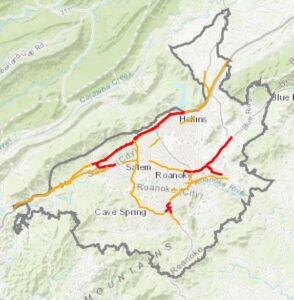The Roanoke Valley doesn’t have much severe traffic congestion – and we want to keep it that way! After the population of the urbanized region exceeded 200,000, the RVTPO adopted its first federally required congestion management process in 2014. The 2020 Traffic Congestion Management Process, approved on October 22, is the first update, incorporating changes in technology and regulations, data analyses, and stakeholder input.
The update identifies five priority corridors for congestion management identified through analysis of real-time data collected from GPS-equipped vehicles and mobile devices as well as corridors of concern identified through public input. View the interactive map of corridors for congestion management here.
Learn more about the update of the Traffic Congestion Management Process here.

